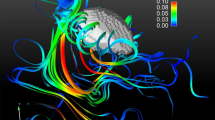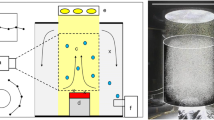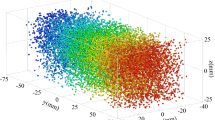Abstract
To measure large-scale flow structures in air, a tomographic particle image velocimetry (tomographic PIV) system for measurement volumes of the order of one cubic metre is developed, which employs helium-filled soap bubbles (HFSBs) as tracer particles. The technique has several specific characteristics compared to most conventional tomographic PIV systems, which are usually applied to small measurement volumes. One of them is spot lights on the HFSB tracers, which slightly change their position, when the direction of observation is altered. Further issues are the large particle to voxel ratio and the short focal length of the used camera lenses, which result in a noticeable variation of the magnification factor in volume depth direction. Taking the specific characteristics of the HFSBs into account, the feasibility of our large-scale tomographic PIV system is demonstrated by showing that the calibration errors can be reduced down to 0.1 pixels as required. Further, an accurate and fast implementation of the multiplicative algebraic reconstruction technique, which calculates the weighting coefficients when needed instead of storing them, is discussed. The tomographic PIV system is applied to measure forced convection in a convection cell at a Reynolds number of 530 based on the inlet channel height and the mean inlet velocity. The size of the measurement volume and the interrogation volumes amount to 750 mm × 450 mm × 165 mm and 48 mm × 48 mm × 24 mm, respectively. Validation of the tomographic PIV technique employing HFSBs is further provided by comparing profiles of the mean velocity and of the root mean square velocity fluctuations to respective planar PIV data.























Similar content being viewed by others
References
Ahlers G, Grossmann S, Lohse D (2009) Heat transfer and large scale dynamics in turbulent Rayleigh-Bénard convection. Rev Mod Phys 81:503–537
Atkinson CH, Soria J (2007) Algebraic reconstruction techniques for tomographic particle image velocimetry. In: 16th Australasian Fluid Mechanics Conference, Gold Coast, QLD, Australia
Atkinson C, Soria J (2009) An efficient simultaneous reconstruction technique for tomographic particle image velocimetry. Exp Fluids 47:553–568
Biwole PH, Yan W, Zhang Y, Roux JJ (2009) A complete 3D particle tracking algorithm and its applications to the indoor airflow study. Meas Sci Technol 20:115403
Bosbach J, Penneçot J, Wagner C, Raffel M, Lerche T, Repp S (2006) Experimental and numerical simulations of turbulent ventilation in aircraft cabins. Energy 31:694–705
Bosbach J, Kühn M, Wagner C (2009) Large scale particle image velocimetry with helium filled soap bubbles. Exp Fluids 46:539–547
Bracewell RN (1978) The Fourier transform and its applications, 2nd edn. McGraw Hill, New York
Elsinga GE, van Oudheusden BW, Scarano F (2006a) Experimental assessment of Tomographic-PIV accuracy. In: 13th Int Symp on Applications of Laser Techniques to Fluid Mechanics, Lisbon, Portugal
Elsinga GE, Scarano F, Wieneke B, van Oudheusden BW (2006b) Tomographic particle image velocimetry. Exp Fluids 41:933–947
Elsinga GE, Westerweel J, Scarano F, Novara M (2009) On the velocity of ghost particles. In: 8th Int Symp on Particle Image Velocimetry, Melbourne, VIC, Australia
Graftieaux L, Michard M, Grosjean N (2001) Combining PIV, POD and vortex identification algorithms for the study of unsteady turbulent swirling flows. Meas Sci Technol 12:1422–1429
Hain R, Kähler CJ, Michaelis D (2008) Tomographic and time resolved PIV measurements on a finite cylinder mounted on a flat plate. Exp Fluids 45:715–724
Herman GT, Lent A (1976) Iterative reconstruction algorithms. Comp Biol Med 6:273–294
Humble RA, Elsinga GE, Scarano F, van Oudheusden BW (2009) Three-dimensional instationary structure of a shock wave/turbulent boundary layer interaction. J Fluid Mech 622:33–62
Kühn M, Bosbach J, Wagner C (2009) Experimental parametric study of forced and mixed convection in a passenger aircraft cabin mock-up. Build Environ 44:961–970
Kunnen RPJ, Clercx HJH, Geurts BJ, van Bokhoven LJA, Akkermans RAD, Verzicco R (2008) Numerical and experimental investigation of structure-function scaling in turbulent Rayleigh-Bénard convection. Phys Rev E 77:016302
Lobutova E, Resagk C, Rank R, Müller D (2009) Extended three dimensional particle tracking velocimetry for large enclosures. Imaging measurement methods for flow analysis. NNFM 106:113–124
Machacek M (2003) A quantitative visualization tool for large wind tunnel experiments. PhD thesis, Eidgenösische Technische Hochschule Zürich, Zürich, Switzerland
Michaelis D, Wieneke B (2008) Comparison between tomographic PIV and stereo PIV. In: 14th Int Symp on Applications of Laser Techniques to Fluid Mechanics, Lisbon, Portugal
Mueller K (1998) Fast and accurate three-dimensional reconstruction from cone-beam projection data using algebraic methods. PhD thesis, The Ohio State University, Columbus, OH, USA
Müller RHG, Flögel H, Scherer T, Schaumann O, Markwart M (2000) Investigation of large scale low speed air conditioning flow using PIV. In: 9th Int Symp on Flow Visualization, Edinburgh, UK
Niemela J, Skrbek L, Sreenivasan KR, Donelly RJ (2001) The wind in confined thermal convection. J Fluid Mech 449:169–178
Ortiz-Duenas C, Kim J, Longmire EK (2010) Investigation of liquid-liquid drop coalescence using tomographic-PIV. Exp Fluids 49:111–129
Raffel M, Willert CE, Wereley ST, Kompenhans J (2007) Particle image velocimetry—a practical guide, 2nd edn. Springer, Berlin
Sandberg M (2007) Whole-field measuring methods in ventilated rooms. HVAC R Res 13:951–970
Scarano F, Poelma C (2009) Three-dimensional vorticity patterns of cylinder wakes. Exp Fluids 47:69–83
Schmeling D, Westhoff A, Kühn M, Bosbach J, Wagner C (2010) Flow structure formation of turbulent mixed convection in a closed rectangular cavity. New results in numerical and experimental fluid mechanics VII. NNFM 112:553–560
Schröder A, Geisler R, Elsinga GE, Scarano F, Dierksheide U (2008) Investigation of a turbulent spot and a tripped turbulent boundary layer flow using time-resolved tomographic PIV. Exp Fluids 44:305–316
Soloff SM, Adrian RJ, Liu ZC (1997) Distortion compensation for generalized stereoscopic particle image velocimetry. Meas Sci Technol 8:1441–1454
Sun Y, Zhang Y (2003) Development of a stereoscopic particle image velocimetry system for full-scale room airflow studies, Part II: experimental setup. ASHRAE Trans 109:540–548
Sun Y, Zhang Y (2007) An overview of room air motion measurement: technology and application. HVAC R Res 13:929–950
Sun Y, Zhang Y, Zhao L, Wang X (2004) An algorithm of stereoscopic particle image velocimetry for full-scale room airflow studies. ASHRAE Trans 110:75–80
Sun Y, Zhang Y, Wang A, Topmiller JL, Bennett JS (2005) Experimental characterization of airflows in aircraft cabins, Part I: experimental system and measurement procedure. ASHRAE Trans 111:45–52
Thévenaz P, Blu T, Unser M (2000) Interpolation revisited. IEEE Trans Med Imaging 19:739–758
Westerweel J, Scarano F (2005) Universal outlier detection for PIV data. Exp Fluids 39:1096–1100
Westhoff A, Grabinski N, Bosbach J, Wagner C (2007) Scaling of turbulent mixed convection under high pressure. In: 7th Int Symp on Turbulence and Shear Flow Phenomena, Garching, Germany
Wieneke B (2008) Volume self-calibration for 3D particle image velocimetry. Exp Fluids 45:549–556
Worth NA, Nickels TB (2008) Acceleration of Tomo-PIV by estimating the initial volume intensity distribution. Exp Fluids 45:847–856
Xia KQ, Sun C, Zhou SQ (2003) Particle image velocimetry measurement of the velocity field in turbulent thermal convection. Phys Rev E 68:066303
Zhang Y, Sun Y, Wang A, Topmiller JL, Bennett JS (2005) Experimental characterization of airflow in aircraft cabins, Part II: results and research recommendations. ASHRAE Trans 111:53–59
Acknowledgments
The help of Janos Agocs with the test set-up is appreciated. The authors further acknowledge Tobias Dehne for his work during the development of the LED light source.
Author information
Authors and Affiliations
Corresponding author
Appendix
Appendix
The line integral through a spherically symmetric interpolation kernel f(r) is equivalent to the Abel transform of the function (Bracewell 1978). The Abel transform of f(r) is defined as
where r is the radius and d the minimal distance between the centre of the function and the integration path (see Fig. 6).
In the present investigation, a bilinear interpolation kernel
is used. Therby r max is the radius of the filter and chosen to be equal to the side length of a voxel. The Abel transform of the bilinear interpolation kernel is finally
whereas the upper integration limit is set to r max. In order to have a line integral, respectively, weighting coefficient between 0 and 1 the value is normalised with f A (d = 0). Using this transformation, it is assumed that the integration is performed along a straight line.
Rights and permissions
About this article
Cite this article
Kühn, M., Ehrenfried, K., Bosbach, J. et al. Large-scale tomographic particle image velocimetry using helium-filled soap bubbles. Exp Fluids 50, 929–948 (2011). https://doi.org/10.1007/s00348-010-0947-4
Received:
Revised:
Accepted:
Published:
Issue Date:
DOI: https://doi.org/10.1007/s00348-010-0947-4




